For my second visit to Auburn Avenue, I decided to analyze the entire street, along with its intersecting streets, to observe what this area’s character is. Historically, it is well known to have been a wealthy, influential neighborhood in the times of the Civil Rights Movement. But today, it has lost its glory in many ways.
IN A NUTSHELL
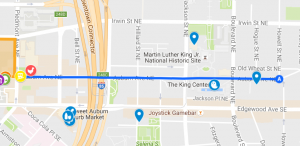
The street blocks of Auburn Avenue that are located between Piedmont Avenue and Howell Street are sectioned off by their history and their culture. Though the area was once entirely a street of commonalities and social progressivism, it now has divides. Some parts are willing to change and adapt to today’s culture, whereas other parts are dedicated to keeping the history alive, and honoring the culture of the past.
THE BEGINNING OF THE END: Between Piedmont Avenue & Jesse Hill Jr. Drive
I walked east down Auburn Avenue from Piedmont Avenue. On the first block, between Piedmont and Jesse Hill Jr. Drive NE, there were about ten or so people walking along the sidewalks, mostly because of the transit stop there, but also because of the few restaurants and shops that occupy the space.

At the corner of Jesse Hill Jr. Drive and Auburn Avenue, there are two large murals: one of Martin Luther King Jr. with his famous quote, “In the end, we will remember not the words of our enemies, but the silence of our friends,” and the other is of John Lewis, with the quote, “I appeal to all of you to get into this great revolution sweeping this nation. Get in and stay in the streets of every city, every village and hamlet of this nation until true freedom comes, until the revolution of 1776 is complete.” These murals are facing one another, as if in constant communication and alliance. It is especially fitting for these two murals to be placed at the intersection of these two streets, since . Jesse Hill Jr. worked for the Atlanta Life Insurance Company and, as a man with great authority, instructed his company to quietly underwrite certain civil rights initiatives, such as bailing out individuals arrested for participating in non-violent protests. This intersection commemorates and encourages friendship, speaking out, and community involvement in today’s culture.
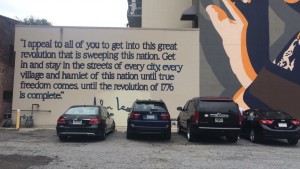

NOW IS THE NEW THEN: New businesses occupy the spaces of old.
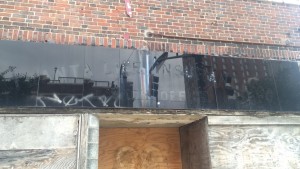
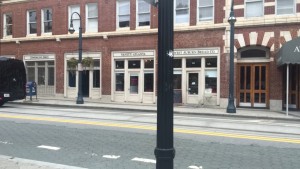
Walking past this intersection, on the adjacent corner on a light post is a sign, “DRUG TESTING OFFICE 1ST FLOOR.” Well, that was quite a change in morality from one street to another. This sign is situated on the corner, right in front of an abandoned building that is boarded up, which just so happened to have been the Atlanta Insurance Company Branch Office, whose title is visible, though faded. Across the street, there are various offices of small businesses, occupying the historic building of the Atlanta Chapter of the Grand Order of Odd Fellows (a fraternal organization supporting and networking the black business community), who built this substantial building as their headquarters and to provide much needed office, retail, professional meeting and entertainment space for African Americans. Going to the corner, there is a restaurant called “Wok n Roll” which also occupies the building of the headquarters for the Odd Fellows.
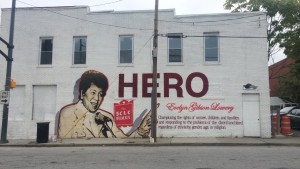
Across the street, on the left-hand corner of Auburn Avenue and Bell Street, there is another mural, and this one is of Evelyn Gibson Lowery next to a painting sign for the SCLC women, and the words “Championing the rights of women, children, and families, and responding to the problems of the disenfranchised regardless of ethnicity, gender, age, or religion.” Upon trying to find out what this building was originally used for, I was unable to find any site to propose a special purpose, and only retail listings as office space, and a recent history of being the Black Lion nightclub, and then the Connect Lounge. The space is currently boarded up.
HISTORY: Don’t let go, Auburn!
AUBURN: I’ll never let go!
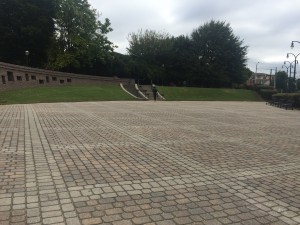
Next, I continued walking, past the bridge, and across Fort Street, to the beginning of the King Historic District at John Wesley Dobbs Plaza. There are only a few people around this immediate area, mostly homeless, but there is a lot of traffic down Fort Street because of its vicinity to the highway, so it gets a lot louder around here, but it quickly became quiet as I walked further down. The plaza did however have a sign, explaining the decline of Auburn Avenue. It also explains how the culture of the buildings and people between Fort Street and Bell Street were thought of as less important than the new era of highways and urban development. Between Fort Street and Howell Street, there is a mixture of boarded up, closed businesses, historic sites and organizations, as well as new businesses which seem to alternate up and down the building space. There is the Southern Christian Leadership Conference building, then an Escape the Room recreational business, and then a Women’s Southern Christian Leadership building.
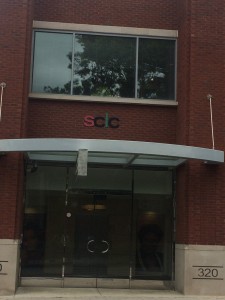
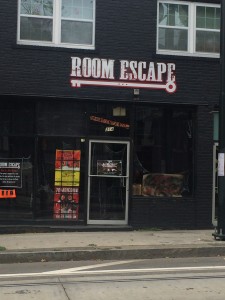
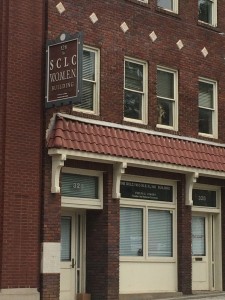
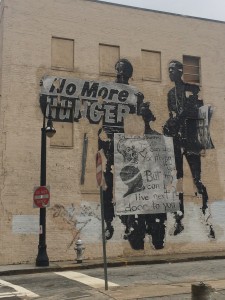
There is another mural across Hilliard Street, which highlights the white flight era and one of the main reasons for the decline of the street. But it also speaks culturally, as the area is still a black neighborhood. From this area on, up until Howell Street and Old Fourth Ward, there is the King Center and other churches. The area is almost entirely the same as in the past, besides minor renovations to the buildings, and the addition of statues and commemorative landmarks. To learn more about the Martin Luther King Historic Site, you may visit this web address to learn more. You may also check out my first built environment description about the historic Ebenezer Baptist Church.